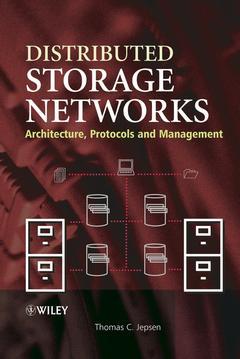Distributed Storage Networks Architecture, Protocols and Management
Auteur : Jepsen Thomas C.

The worldwide market for SAN and NAS storage is anticipated to grow from US $2 billion in 1999 to over $25 billion by 2004. As business-to-business and business-to-consumer e-commerce matures, even greater demands for management of stored data will arise.
With the rapid increase in data storage requirements in the last decade, efficient management of stored data becomes a necessity for the enterprise. A recent UC-Berkeley study predicts that 150,000 terabytes of disk storage will be shipped in 2003. Most financial, insurance, healthcare, and telecommunications institutions are in the process of implementing storage networks that are distributed to some degree. For these institutions, data integrity is critical, and they will spend much time and money on planning.
One of the primary obstacles to implementing a storage network cited by enterprise IT managers is a lack of knowledge about storage networking technology and the specific issues involved in extending a Storage Area Network (SAN) or Network Attached Storage (NAS) over the Metropolitan Area Networks (MAN) or Wireless Area Networks (WAN). Distributed Storage Networks: Architecture, Protocols and Management addresses the "terminology gap" between enterprise network planners and telecommunications engineers, who must understand the transport requirements of storage networks in order to implement distributed storage networks. Jepsen comprehensively provides IT managers, planners, and telecommunications professionals with the information they need in order to choose the technologies best suited for their particular environment.
- Addresses a hot topic that will become increasingly important in the coming years
- Enables high-level managers and planners to make intelligent decisions about network needs
- Includes example network configurations providing solutions to typical user scenarios
- Fills the "terminology gap" between enterprise network managers and telecommunications engineers who must understand the transport requirements of storage networks in order to implement distributed storage area networks
A fundamental resource for all network managers, planners and network design engineers, as well as telecommunications engineers and engineering, computer science, and information technology students.
Preface.
Acknowledgements.
List of Figures.
List of Tables.
1. Introduction to Storage Networking.
1.1 Overview.
1.2 Evolution of Storage Netwroking.
1.3 Terminology.
1.4 Storage Concepts.
1.5 SAN Applications.
1.6 Summary.
2. Applications for Distributed Storage Networking.
2.1 Storage Integration.
2.2 Remote Backup/Restoral.
2.3 Disk Mirroring.
2.4 Data Migration.
2.5 Business Continuity/Disaster Recovery.
2.6 Remote Operation of Peripheral Devices.
2.7 Mainframe/Open Systems Connectivity.
2.8 Network Attached Storage (NAS).
2.9 Summary.
3. Distance Considerations for Storage Networks.
3.1 Physical Layer.
3.2 Protocol Considerations.
3.3 Caching.
3.4 Summary.
4. Architectures for Distributed Storage Networking.
4.1 Storage Networking in the Business Park.
4.2 Storage Networking in the Metro Network.
4.3 Storage Networking in the Wide Area Network.
4.4 Summary.
5. Protocols for Distributed Storage Networking.
5.1 Small Computer Systems Interface (SCSI).
5.2 Enterprise Systems Connection (ESCON).
5.3 Fiber Connection (FICON).
5.4 Fibre Channel (FC).
5.5 Gigabit Ethernet (GigE) and 10 Gigabit Ethernet (10G Ethernet).
5.6 Protocol Summary.
6. InfiniBand.
6.1 Applications.
6.2 Standards.
6.3 Network Topology.
6.4 Addressing.
6.5 Data Framing.
6.6 Physical layer.
6.7 Summary.
7. MAN/WAN Protocols for Distributed Storage Networking.
7.1 Wavelength Division Multiplexing (WDM).
7.2 Time Division Multiplexing and SONET.
7.3 Asynchronous Transfer Mode (ATM).
7.4 Generic Framing Procedure (GFP).
7.5 Summary - WAN/MAN Protocols.
8. Storage Over IP.
8.1 Overview.
8.2 Internet SCSI (iSCSI).
8.3 Fibre Channel and IP Netwroks.
8.4 Summary.
9. Storage Management Requirements.
9.1 Overview.
9.2 Standards.
9.3 The SNIA Shared Storage Model.
9.4 The SNIA Management Model.
9.5 The SNIA Prototype.
9.6 Distance Considerations for Storage management.
9.7 Summary.
10. Security Considerations.
10.1 Overview.
10.2 Physical Security.
10.3 User Login and Administration.
10.4 Management Interfaces.
10.5 Firewalls.
10.6 Encryption and IPSec.
10.7 Public Key Infrastructure and Digital Certificates.
10.8 Virtual Private Networks (VPNs).
10.9 SAN Security.
10.10 NAS Security.
10.11 Analyzing Network Architecture for Security Issues.
10.12 Summary.
11. Planning Distributed Storage Networks.
11.1 Selexting an Architecture.
11.2 Optical Fiber Planning.
11.3 Security Planning.
11.4 Outsourcing Storage.
11.5 Return on Investment (ROI).
11.6 Summary.
12. Glossary of Terms.
Bibliography.
Index.
Thomas C. Jepsen is Programming Languages Editor for IEEE IT Professional Magazine and a telecommunications industry professional who has developed a number of telecommunications-related Java applications, including graphical user interfaces and an application programming interface for Asynchronous Transfer Mode (ATM).
Date de parution : 11-2003
Ouvrage de 338 p.
17.5x24.9 cm
Thème de Distributed Storage Networks :
Mots-clés :
capacity; storage; underutilized; every; efficient; data; enterprise; necessity; increased; creates; high; reliability; downtime; cost; systems; distributed; need; manage; performance; survivability; increase; access; use; networks
